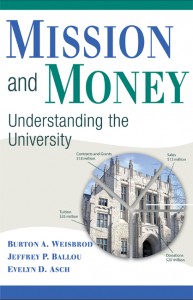Higher education is an industry like any other. There is no sheltered ivory tower rising above real world financial pressure: it requires funding and responds to cycles of supply and demand. That’s where endowments come in. Often considered vital to the financial health of private colleges and universities, endowments provide necessary income for the yearly budget as well as a safety net of savings for a rainy day – for if, say, the economy falls into a recession. Why, then, are leading academic institutions hoarding their money while slashing faculty, financial aid, and programs?
On Inside Higher Ed, Burton A. Weisbrod and Evelyn D. Asch, co-authors of Mission and Money, ask just that. When rethinking college endowments, how much is enough?
——–

The cost of a college education is soaring. Meanwhile, colleges and universities with stratospheric endowments are husbanding their wealth. Why?
Endowments provide income for important spending each year. But they also are a college’s savings — their insurance for a rainy-day loss in revenue. With insurance, a college can sustain its programs even when bad times cause donations, tuition revenue, or government grants to shrink. Clearly, we have been having a very rainy day. Yet colleges and universities with the largest rainy day funds have been cutting expenditures rather than drawing down their endowments to continue their activities and fulfill their mission until the economy improves. To be sure, even the wealthiest universities can benefit from scrutinizing their budgets for waste, duplication or programs that didn’t work out, but the cuts we are seeing extend to limiting admission to doctoral programs, eliminating valuable education programs and laying off long-time, valued employees.
Many colleges, private and public, have little or no savings. A third of community colleges and 11 percent of four-year nonprofit and public colleges and universities, attended by 2.4 million students, have no endowment. When revenue falls, these schools have little alternative but to cut faculty, eliminate programs, furlough staff, shrink financial aid to needy students, and in other ways try to live within their means. But since those colleges never counted on their endowments for much revenue, they are not suffering as much from the lower endowment values.
Keep reading at Inside Higher Ed >>>
Rainy Days in Higher Ed
Higher education is an industry like any other.There is no sheltered ivory tower rising above real world financial pressure: it requires funding and responds to cycles of supply and demand.That’s where endowments come in. Often considered vital to the financial health of private colleges and universities, endowments provide necessary income for the yearly budget as well as a safety net of savings for a rainy day – for if, say, the economy falls into a recession.Why, then, are leading academic institutions hoarding their money while slashing faculty, financial aid, and programs?
On Inside Higher Ed, Burton Weisbrod and Evelyn D. Asch, co-authors of Mission and Money (HYPERLINK TO BOOK’S PAGE), ask just that.When rethinking college endowments, how much is enough?
Latest Comments
Have your say!